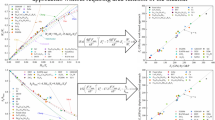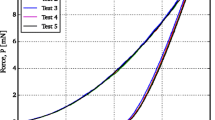Abstract
In the analysis of instrumented indentation data, it is common practice to incorporate the combined moduli of the indenter (Ei) and the specimen (E) in the so-called reduced modulus (Er) to account for indenter deformation. Although indenter systems with rigid or elastic tips are considered as equivalent if Er is the same, the validity of this practice has been questioned over the years. The present work uses systematic finite element simulations to examine the role of the elastic deformation of the indenter tip in instrumented indentation measurements and the validity of the concept of the reduced modulus in conical and pyramidal (Berkovich) indentations. It is found that the apical angle increases as a result of the indenter deformation, which influences in the analysis of the results. Based upon the inaccuracies introduced by the reduced modulus approximation in the analysis of the unloading segment of instrumented indentation applied load (P)–penetration depth (δ) curves, a detailed examination is then conducted on the role of indenter deformation upon the dimensionless functions describing the loading stages of such curves. Consequences of the present results in the extraction of the uniaxial stress–strain characteristics of the indented material through such dimensional analyses are finally illustrated. It is found that large overestimations in the assessment of the strain hardening behavior result by neglecting tip compliance. Guidelines are given in the paper to reduce such overestimations.















Similar content being viewed by others
References
W.C. Oliver and G.M. Pharr: An improved technique for determining hardness and elastic modulus using load and sensing indentation experiments. J. Mater. Res. 7, 1564 (1992).
M. Dao, N. Chollacoop, K.J. Van Vliet, T.A. Venkatesh, and S. Suresh: Computational modeling of the forward and reverse problems in instrumented sharp indentation. Acta Mater. 49, 3899 (2001).
O. Casals and J. Alcalá: The duality in mechanical property extractions from Vickers and Berkovich instrumented indentation experiments. Acta Mater. 53, 3545 (2005).
K.L. Johnson: Contact Mechanics (Cambridge University Press, Cambridge, 1985).
S.A. Rodríguez, R.M. Souza, and J. Alcalá: A critical reassessment of the elastic unloading in sharp instrumented indentation experiments: Mechanical properties extraction. Philos. Mag. 91, 1409 (2011).
M.M. Chaudhri: A note on a common mistake in the analysis of nanoindentation data. J. Mater. Res. 16, 336 (2001).
Y.Y. Lim and M.M. Chaudhri: Experimental investigations of the normal loading of elastic spherical and conical indenters on to elastic flats. Philos. Mag. 83, 3427 (2003).
S.M. Jeong and H.L. Lee: Finite element analysis of the tip deformation effect on nanoindentation hardness. Thin Solid Films 492, 173–179 (2005).
A.C. Ficher-Cripps: Use of combined elastic modulus in depth-sensing indentation with a conical indenter. J. Mater. Res. 18, 1043–1045 (2003).
Y.Y. Lim and M.M. Chaudhri: Indentation of elastic solids with rigid cones. Philos. Mag. 84, 2877–2903 (2004).
I. Choi, O. Kraft, and R. Schwaiger: Validity of the reduced modulus concept to describe indentation loading response for elastoplastic materials with sharp indenters. J. Mater. Res. 24, 998–1006 (2009).
M. Troyon and L.Y. Huang: Correction factor for contact area in nanoindentation measurements. J. Mater. Res. 20, 610–617 (2005).
M.G.J. Veprek-Heijman, R.G. Veprek, A.S. Argon, D.M. Parks, and S. Veprek: Non-linear finite element constitutive modeling of indentation into super- and ultrahard materials: The plastic deformation of the diamond tip and the ratio of hardness to tensile yield strength of super- and ultrahard nanocomposites. Surf. Coat. Technol. 203, 3385–3391 (2009).
K.W. McElhaney, J.J. Vlassak, and W.D. Nix: Determination of indenter tip geometry and indentation contact area for depth-sensing indentation experiments. J. Mater. Res. 13, 1300–1306 (1998).
J. Gong, H. Miao, and Z. Peng: On the contact area for nanoindentation tests with Berkovich indenter: Case study on soda-lime glass. Mater. Lett. 58, 1349–1353 (2004).
Y.P. Cao, M. Dao, and J. Lu: A precise correcting method for the study of the superhard material using nanoindentation tests. J. Mater. Res. 22, 1255–1264 (2007).
A.E.H Love: Boussinesq’s problem for a rigid cone. Q. J. Math. 10, 161–175 (1939).
I.N. Sneddon: The relation between load and penetration in the axisymmetric boussinesq problem for a punch of arbitrary profile. Int. J. Eng. Sci. 3, 47–57 (1965).
S.I. Bulychev, V.P. Alekhin, M.Kh. Shorshorov, A.P. Ternovskii, and G.D. Shnyrev: Determining Young’s modulus from the indenter penetration diagram. Ind. Lab., 41, 1409–1412 (1975).
J.C. Hay, A. Bolshakov, and G.M. Pharr: A critical examination of the fundamental relations used in the analysis of nanoindentation data. J. Mater. Res. 14, 2296–2305 (1999).
S.A. Rodríguez, M.C. Farias, and R.M. Souza: Finite element and dimensional analysis algorithm for the prediction of mechanical properties of bulk materials and thin films. Surf. Coat. Technol. 205, 1386–1392 (2010).
Y.T. Cheng and C.M. Cheng: Scaling, dimensional analysis, and indentation measurements. Mater. Sci. Eng., R. 44, 91–149 (2004).
J. Alcalá and D. Esqué-De Los Ojos: Reassessing spherical indentation: Contact regimes and mechanical property extractions. Int. J. Solids Struct. 47, 2714–2732 (2010).
M. Mata and J. Alcalá: The role of friction on sharp indentation. J. Mech. Phys. Solids 52, 145 (2004).
E. Harsono, S. Swaddiwudhipong, and Z.S. Liu: The effect of friction on indentation test results. Modell. Simul. Mater. Sci. Eng. 16, 065001 (2008).
S.A. Rodríguez, M.C. Farias, and R.M. Souza: Analysis of the tip roundness effects on the micro- and macroindentation response of elastic-plastic materials. J. Mater. Res. 24, 1037–1044 (2009).
S.A. Rodríguez, M.C. Farias, and R.M. Souza: Analysis of the effects of conical indentation variables on the indentation response of elastic-plastic materials through factorial design of experiment. J. Mater. Res. 24, 1222–1234 (2009).
C.E.K Mady, S.A. Rodríguez, A.G. Gómez, and R.M. Souza: Effects of mechanical properties, residual stress and indenter tip geometry on instrumented indentation data in thin films. Surf. Coat. Technol. 205, 1393–1397 (2010).
W.C. Oliver and G.M. Pharr: Measurement of hardness and elastic modulus by instrumented indentation: Advances in understanding and refinements to methodology. J. Mater. Res. 19, 3–20 (2004).
Y. Sun, S. Zheng, T. Bell, and J. Smith: Indenter tip radius and load frame compliance calibration using nanoindentation loading curves. Philos. Mag. Lett. 79, 649–658 (1999).
Y.T. Cheng and C.M. Cheng: Relationships between hardness, elastic modulus, and the work of indentation. Appl. Phys. Lett. 73, 614–616 (1998).
Y.P. Cao, X.Q. Qian, J. Lu, and Z.H. Yao: An energy-based method to extract plastic properties of metal materials from conical indentation tests. J. Mater. Res. 20, 1194–1206 (2005).
R.B. King: Elastic analysis of some punch problems for a layered medium. Int. J. Solids Struct. 23, 1657–1664 (1987).
S.A. Rodríguez: Modelamento do Ensaio de Indentação Instrumentada Usando Elementos Finitos e Análise Dimensional–Análise de Unicidade, Variações Experimentais, Atrito e Geometria e Deformações do Indentador. Ph.D. Thesis, University of São Paulo, São Paulo, Brazil, 2010.
O. Casals, J. Ocenasek, and J. Alcalá: Crystal plasticity finite element simulations of pyramidal indentation in copper single crystals. Acta Mater. 55, 55–68 (2007).
J. Alcalá, D. Esque-De Los Ojos, and S.A. Rodríguez: The role of crystalline anisotropy in mechanical property extractions through Berkovich indentation. J. Mater. Res. 24, 1235–1244 (2009).
S.A. Rodríguez, J. Alcalá, and R.M. Souza: Effects of elastic indenter deformation on spherical instrumented indentation tests: The reduced elastic modulus. Philos. Mag. 91, 7–9 (2010).
M. Mata and J. Alcalá: Mechanical property evaluation through sharp indentations in elastoplastic and fully plastic contact regimes. J. Mater. Res. 18, 1705–1709 (2003).
O. Casals, J. Alcalá, and J. Očenášek: Micromechanics of pyramidal indentation in fcc metals: Single crystal plasticity finite element analysis. J. Mech. Phys. Solids 56, 3277–3303 (2008).
N.A. Sakharova, J.V. Fernandes, J.M. Antunes, and M.C. Oliveira: Comparison between Berkovich, Vickers and conical indentation tests: A three-dimensional numerical simulation study. Int. J. Solids Struct. 46, 1095–1104 (2009).
S. Swaddiwudhipong, J. Hua, K.K. Tho, and Z.S. Liu: Equivalency of Berkovich and conical load-indentation curves. Modell. Simul. Mater. Sci. Eng. 14, 71–82 (2006).
Acknowledgments
This research was sponsored by the CNPq under Contract No. 141259/2007-8 and by the Spanish Ministry of Education and Science through Project MAT2008-01647/MAT.
Author information
Authors and Affiliations
Corresponding author
Rights and permissions
About this article
Cite this article
Rodríguez, S.A., Alcalá, J. & Souza, R.M. The reduced modulus in the analysis of sharp instrumented indentation tests. Journal of Materials Research 27, 2148–2160 (2012). https://doi.org/10.1557/jmr.2012.164
Received:
Accepted:
Published:
Issue Date:
DOI: https://doi.org/10.1557/jmr.2012.164




